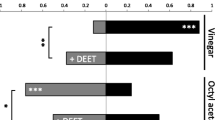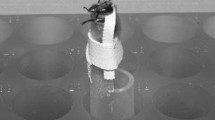Abstract
The aim of this study is to investigate the effects of three volatile oxylipins on colony development in two fungi and on Drosophila larval metamorphosis. Using an airborne exposure technique, three common and volatile oxylipins (1-octen-3-ol, (E)-2-hexenal, and 1-hexanol) were compared for their effects on spore germination and colony growth in Aspergillus niger and Penicillium chrysogenum, as well as for their effects on the morphogenesis of larvae of Drosophila melanogaster. Conidia of both A. niger and P. chrysogenum plated in the presence of low concentrations (50 ppm) of these three volatile organic compounds (VOCs) formed fewer colony-forming units (CFUs) and exhibited reduced radial growth of colonies as compared to controls. When A. niger and P. chrysogenum spores were germinated in the presence of the enantiomers of 1-octen-3-ol, (R)-(−)-1-octen-3-ol had the greatest impact on colony morphology (decreased sporulation and colony diameter), while (S)-(+)-1-octen-3-ol and the racemic form yielded similar morphological changes but to a lesser extent. In addition, Drosophila larvae exposed to vapors of these oxylipins exhibited serious delays in metamorphosis and toxic effects on pupae and adult stages. Low concentration of these three VOCs can significantly inhibit the formation of CFUs and the growth of fungi. (R)-(−)-1-octen-3-ol imposed the greatest impact on fungal morphology compared to (S)-(+)-1-octen-3-ol and the racemic form. The three volatile oxylipins could also delay the metamorphosis of Drosophila and impose toxic effects on its pupae and adult stages.





Similar content being viewed by others
References
Amaike S, Keller NP (2009) Distinct roles for VeA and LaeA in development and pathogenesis of Aspergillus flavus. Eukaryot Cell 8:1051–1060
Archbold DD, Hamiltonkemp TR, Barth MM, Langlois BE (1997) Identifying natural volatile compounds that control gray mold (Botrytis cinerea) during postharvest storage of strawberry, blackberry, and grape. J Agric Food Chem 45:4032–4037
Berendsen RL, Kalkhove SI, Lugones LG, Baars JJ, Wosten HA, Bakker PA (2013) Effects of the mushroom-volatile 1-octen-3-ol on dry bubble disease. Appl Microbiol Biotechnol 97:5535–5543
Bernier UR, Kline DL, Barnard DR, Schreck CE, Yost RA (2000) Analysis of human skin emanations by gas chromatography/mass spectrometry. 2. Identification of volatile compounds that are candidate attractants for the yellow fever mosquito (Aedes aegypti). Anal Chem 72:747–756
Bitas V, Kim HS, Bennett JW, Kang S (2013) Sniffing on microbes: diverse roles of microbial volatile organic compounds in plant health. Mol Plant Microbe Interact 26:835–843
Blackwell A, Dyer C, Mordue AJ, Wadhams LJ, Mordue W (1996) The role of 1-octen-3-ol as a host-odour attractant for the biting midge, Culicoides impunctatus Goetghebuer, and interactions of 1-octen-3-ol with a volatile pheromone produced by parous female midges. Physiol Entomol 21:15–19
Brodhagen M, Tsitsigiannis DI, Hornung E, Goebel C, Feussner I, Keller NP (2008) Reciprocal oxylipin-mediated cross-talk in the Aspergillus-seed pathosystem. Mol Microbiol 67:378–391
Casey R, West SI, Hardy D, Robinson DS, Wu ZC, Hughes RK (1999) New frontiers in food enzymology: recombinant lipoxygenases. Trends Food Sci Technol 10:297–302
Chan HWS (1987) Autoxidation of unsaturated lipids. Food science and technology. Academic Press, London
Chen H, Fink GR (2006) Feedback control of morphogenesis in fungi by aromatic alcohols. Genes Dev 20:1150–1161
Chitarra GS, Abee T, Rombouts FM, Posthumus MA, Dijksterhuis J (2004) Germination of Penicillium paneum conidia is regulated by 1-octen-3-ol, a volatile self-inhibitor. Appl Environ Microbiol 70:2823–2829
Chitarra GS, Abee T, Rombouts FM, Dijksterhuis J (2005) 1-Octen-3-ol inhibits conidia germination of Penicillium paneum despite of mild effects on membrane permeability, respiration, intracellular pH, and changes the protein composition. FEMS Microbiol Ecol 54:67–75
Cilek JE, Hallmon CF, Johnson R (2011) Semi-field comparison of the BG Lure, nonanal, and 1-octen-3-ol to attract adult mosquitoes in northwestern Florida. J Am Mosq Control Assoc 27:393–397
Combet E, Henderson J, Eastwood DC, Burton KS (2006) Eight-carbon volatiles in mushrooms and fungi: properties, analysis, and biosynthesis. Mycoscience 47:317–326
Corbo MR, Lanciotti R, Gardini F, Sinigaglia M, Guerzoni ME (2000) Effects of hexanal, trans-2-hexenal, and storage temperature on shelf life of fresh sliced apples. J Agric Food Chem 48:2401–2408
Cruz AF, Hamel C, Yang C, Matsubara T, Gan Y, Singh AK, Kuwada K, Ishii T (2012) Phytochemicals to suppress Fusarium head blight in wheat–chickpea rotation. Phytochemistry 78:72–80
Davis TS, Crippen TL, Hofstetter RW, Tomberlin JK (2013) Microbial volatile emissions as insect semiochemicals. J Chem Ecol 39:840–859
De Lucca AJ, Carter-Wientjes CH, Boué S, Bhatnagar D (2011) Volatiletrans-2-hexenal, a soybean aldehyde, inhibits Aspergillus flavus growth and aflatoxin production in corn. J Food Sci 76:M381–M386
Dhillon MK, Singh R, Naresh JS, Sharma HC (2005) The melon fruit fly, Bactrocera cucurbitae: a review of its biology and management. J Insect Sci 5:40
Dijkstra FY, Wikén TO (1976) Studies on mushroom flavours. 1. Organoleptic significance of constituents of the cultivated mushroom, Agaricus bisporus. Z Lebensm Unters Forsch 160:256–262
Feussner I, Wasternack C (2002) The lipoxygenase pathway. Annu Rev Plant Biol 53:275–297
Funk CD (2001) Prostaglandins and leukotrienes: advances in eicosanoid biology. Science 294:1871–1875
Gardini F, Lanciotti R, Guerzoni ME (2001) Effect of trans-2-hexenal on the growth of Aspergillus flavus in relation to its concentration, temperature and water activity. Lett Appl Microbiol 33:50–55
Grant AJ, Dickens JC (2011) Functional characterization of the octenol receptor neuron on the maxillary palps of the yellow fever mosquito, Aedes aegypti. PLoS One 6:e21785
He LF, Beesley TE (2005) Applications of enantiomeric gas chromatography: a review. J Liq Chromatogr Relat Technol 28:1075–1114
Herrero-Garcia E, Garzia A, Cordobes S, Espeso EA, Ugalde U (2011) 8-Carbon oxylipins inhibit germination and growth, and stimulate aerial conidiation in Aspergillus nidulans. Fungal Biol 115:393–400
Herrmann A (2010) The chemistry and biology of volatiles. Wiley, Chichester
Ho C-T, Hartman TG (1994) Lipids in food flavors, vol 558., ACS symposium seriesAmerican Chemical Society, Washington, DC
Hung R, Lee S, Bennett JW (2014) The effects of low concentrations of the enantiomers of mushroom alcohol (1-octen-3-ol) on Arabidopsis thaliana. Mycology 5:73–80
Inamdar AA, Moore JC, Cohen RI, Bennett JW (2012) A model to evaluate the cytotoxicity of the fungal volatile organic compound 1-octen-3-ol in human embryonic stem cells. Mycopathologia 173:13–20
Inamdar AA, Zaman T, Morath SU, Pu DC, Bennett JW (2012) Drosophila melanogaster as a model to characterize fungal volatile organic compounds. Environ Toxicol 29:829–836
Inamdar AA, Hossain MM, Bernstein AI, Miller GW, Richardson JR, Bennett JW (2013) Fungal-derived semiochemical 1-octen-3-ol disrupts dopamine packaging and causes neurodegeneration. Proc Natl Acad Sci U S A 110:19561–19566
Joo YC, Oh DK (2012) Lipoxygenases: potential starting biocatalysts for the synthesis of signaling compounds. Biotechnol Adv 30:1524–1532
Kaminski E, Stawicki S, Wasowicz E (1974) Volatile flavor compounds produced by molds of Aspergillus, Penicillium, and fungi imperfecti. Appl Microbiol 27:1001–1004
Karimifar N, Gries R, Khaskin G, Gries G (2011) General food semiochemicals attract omnivorous German cockroaches, Blattella germanica. J Agric Food Chem 59:1330–1337
Klich MA (2006) Identification of common Aspergillus species. Centraalbureau voor Schimmelcultures, Utrecht
Kline DL (1999) Comparison of two American biophysics mosquito traps: the professional and a new counterflow geometry trap. J Am Mosq Control Assoc 15:276–282
Korpi A, Jarnberg J, Pasanen AL (2009) Microbial volatile organic compounds. Crit Rev Toxicol 39:139–193
Lee JC, Bruck DJ, Curry H, Edwards D, Haviland DR, Van Steenwyk RA, Yorgey BM (2011) The susceptibility of small fruits and cherries to the spotted-wing drosophila, Drosophila suzukii. Pest Manag Sci 67:1358–1367
Leeder AC, Palma-Guerrero J, Glass NL (2011) The social network: deciphering fungal language. Nat Rev Microbiol 9:440–451
Liedtke HC, Abjornsson K, Harraca V, Knudsen JT, Wallin EA, Hedenstrom E, Ryne C (2011) Alarm pheromones and chemical communication in nymphs of the tropical bed bug Cimex hemipterus (Hemiptera: Cimicidae). PLoS One 6:e18156
Luntz AJ (2003) Arthropod semiochemicals: mosquitoes, midges and sealice. Biochem Soc Trans 31:128–133
Matsui K (2006) Green leaf volatiles: hydroperoxide lyase pathway of oxylipin metabolism. Curr Opin Plant Biol 9:274–280
Min DB, Smouse TH, Chang SS (1989) Flavor chemistry of lipid foods., AOCS honored scientist seriesAmerican Oil Chemists Society, Urbana
Morath SU, Hung R, Bennett JW (2012) Fungal volatile organic compounds: a review with emphasis on their biotechnological potential. Fungal Biol Rev 26:73–83
Mosandl A, Heusinger G, Gessner M (1986) Analytical and sensory dfferentiation of 1-octen-3-ol enantiomers. J Agric Food Chem 34:119–122
Mosblech A, Feussner I, Heilmann I (2009) Oxylipins: structurally diverse metabolites from fatty acid oxidation. Plant Physiol Biochem 47:511–517
Moularat S, Robine E, Ramalho O, Oturan MA (2008) Detection of fungal development in a closed environment through the identification of specific VOC: demonstration of a specific VOC fingerprint for fungal development. Sci Total Environ 407:139–146
Nemcovic M, Jakubikova L, Viden I, Farkas V (2008) Induction of conidiation by endogenous volatile compounds in Trichoderma spp. FEMS Microbiol Lett 284:231–236
Neri F, Mari M, Brigati S (2006) Control of Penicillium expansum by plant volatile compounds. Plant Pathol 55:100–105
Neri F, Mari M, Menniti AM, Brigati S (2006) Activity of trans-2-hexenal against Penicillium expansum in ‘Conference’ pears. J Appl Microbiol 100:1186–1193
Noble R, Dobrovin-Pennington A, Hobbs PJ, Pederby J, Rodger A (2009) Volatile C8 compounds and pseudomonads influence primordium formation of Agaricus bisporus. Mycologia 101:583–591
Pitt JI (1979) The genus Penicillium and its teleomorphic states Eupenicillium and Talaromyces. Academic Press, London
Pitt JI, Hocking AD (2009) Fungi and food spoilage, 3rd edn. Springer, Dordrecht
Schuster E, Dunn-Coleman N, Frisvad JC, Van Dijck PW (2002) On the safety of Aspergillus niger—a review. Appl Microbiol Biotechnol 59:426–435
Steiner S, Erdmann D, Steidle JLM, Ruther J (2007) Host habitat assessment by a parasitoid using fungal volatiles. Front Zool 4:10
Tressl R, Bahri D, Engel KH (1982) Formation of eight-carbon and ten-carbon components in mushrooms (Agaricus campestris). J Agric Food Chem 30:89–93
Tripathi P, Dubey NK (2004) Exploitation of natural products as an alternative strategy to control postharvest fungal rotting of fruit and vegetables. Postharvest Biol Technol 32:235–245
Tsitsigiannis DI, Keller NP (2006) Oxylipins act as determinants of natural product biosynthesis and seed colonization in Aspergillus nidulans. Mol Microbiol 59:882–892
Vaughn SF, Gardner HW (1993) Lipoxygenase-derived aldehydes inhibit fungi pathogenic on soybean. J Chem Ecol 19:2337–2345
Wright MS, Greene-McDowelle DM, Zeringue HJ, Bhatnagar D, Cleveland TE (2000) Effects of volatile aldehydes from Aspergillus-resistant varieties of corn on Aspergillus parasiticus growth and aflatoxin biosynthesis. Toxicon 38:1215–1223
Zawirska-Wojtaslak R (2004) Optical purity of (R)-(−)-l-octen-3-ol in the aroma of various species of edible mushrooms. Food Chem 86:113–118
Zimmerman DC, Vick BA (1987) The lipoxygenase pathway. In: Stumpf PK, Mudd JB, Nes WD (eds) The metabolism, structure, and function of plant lipids. Springer, Berlin, pp 383–390
Acknowledgments
We thank Prakash Masurekar, Kayla K. Pennerman, and Shannon Morath for their helpful suggestions and Arati Inamdar for having developed the Drosophila toxicology bioassay and having advised on data presentation. Summer research interns Natalie Naranjo, Emma Staniforth, and Dylan Zimmerman provided technical support; the Rutgers University Research Fund provided financial support; and Bedoukian Research Inc. donated some of the chemicals. SL has been supported by the National Science Foundation Graduate Research Fellowship Program under Grant No. (0937373).
Author information
Authors and Affiliations
Corresponding author
Ethics declarations
Conflict of interest
The authors have declared that no competing interest exists.
Rights and permissions
About this article
Cite this article
Yin, G., Padhi, S., Lee, S. et al. Effects of Three Volatile Oxylipins on Colony Development in Two Species of Fungi and on Drosophila Larval Metamorphosis. Curr Microbiol 71, 347–356 (2015). https://doi.org/10.1007/s00284-015-0864-0
Received:
Accepted:
Published:
Issue Date:
DOI: https://doi.org/10.1007/s00284-015-0864-0




